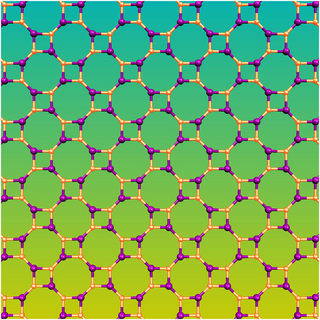 | |
Screenshot of the main view in CoNTub 1.0. | |
| Developer(s) | Grupo de Modelización y Diseño Molecular [1] [2] |
|---|---|
| Initial release | April 2004 |
| Stable release | 2.0 / September 2011 |
| Operating system | Cross-platform. |
| Type | Cheminformatics / Molecular modelling |
| License | freeware |
| Website | www |
CoNTub is a software project written in Java which runs on Windows, Mac OS X, Linux and Unix Operating systems through any Java-enabled web browser. It is the first implementation of an algorithm for generating 3D structures of arbitrary carbon nanotube connections by means of the placement of non-hexagonal (pentagonal or heptagonal) rings, also referred as defects or disclinations.

Java is a general-purpose computer-programming language that is concurrent, class-based, object-oriented, and specifically designed to have as few implementation dependencies as possible. It is intended to let application developers "write once, run anywhere" (WORA), meaning that compiled Java code can run on all platforms that support Java without the need for recompilation. Java applications are typically compiled to "bytecode" that can run on any Java virtual machine (JVM) regardless of the underlying computer architecture. The language derives much of its original features from SmallTalk, with a syntax similar to C and C++, but it has fewer low-level facilities than either of them. As of 2016, Java was one of the most popular programming languages in use, particularly for client-server web applications, with a reported 9 million developers.
Microsoft Windows is a group of several graphical operating system families, all of which are developed, marketed, and sold by Microsoft. Each family caters to a certain sector of the computing industry. Active Windows families include Windows NT and Windows Embedded; these may encompass subfamilies, e.g. Windows Embedded Compact or Windows Server. Defunct Windows families include Windows 9x, Windows Mobile and Windows Phone.

Linux is a family of free and open-source software operating systems based on the Linux kernel, an operating system kernel first released on September 17, 1991 by Linus Torvalds. Linux is typically packaged in a Linux distribution.
Contents
- Features
- Nanotube generation
- Heterojunction generation
- C3 Symmetric Three-Nanotube Junction generation
- Image gallery
- See also
- References
The software is a set of tools dedicated to the construction of complex carbon nanotube structures for use in computational chemistry. CoNTub 1.0[1] was the first implementation for building these complex structures and included nanotube heterojunctions, while CoNTub 2.0[2] is mainly devoted to three-nanotube junctions. Its aim is to help in the design and research about new nanotube-based devices. CoNTub is based on the strip algebra, and is able to find the unique structure for connecting two specific and arbitrary carbon nanotubes and many of the possible three-tube junctions.

Carbon nanotubes (CNTs) are allotropes of carbon with a cylindrical nanostructure. These cylindrical carbon molecules have unusual properties, which are valuable for nanotechnology, electronics, optics, and other fields of materials science and technology. Owing to the material's exceptional strength and stiffness, nanotubes have been constructed with a length-to-diameter ratio of up to 132,000,000:1, significantly larger than that for any other material.
Computational chemistry is a branch of chemistry that uses computer simulation to assist in solving chemical problems. It uses methods of theoretical chemistry, incorporated into efficient computer programs, to calculate the structures and properties of molecules and solids. It is necessary because, apart from relatively recent results concerning the hydrogen molecular ion, the quantum many-body problem cannot be solved analytically, much less in closed form. While computational results normally complement the information obtained by chemical experiments, it can in some cases predict hitherto unobserved chemical phenomena. It is widely used in the design of new drugs and materials.
Strip Algebra is a set of elements and operators for the description of carbon nanotube structures, considered as a subgroup of polyhedra, and more precisely, of polyhedra with vertices formed by three edges. This restriction is imposed on the polyhedra because carbon nanotubes are formed of sp2 carbon atoms. Strip Algebra was developed initially for the determination of the structure connecting two arbitrary nanotubes, but has also been extended to the connection of three identical nanotubes
CoNTub generates the geometry of various types of nanotube junctions, i.e., nanotube heterojunctions and three-nanotube junctions, including also single-walled nanotubes (SWNTs) and multi-walled nanotubes (MWNTs).

Geometry is a branch of mathematics concerned with questions of shape, size, relative position of figures, and the properties of space. A mathematician who works in the field of geometry is called a geometer.
Although the current version of CoNTub is v2.0, this version does not supersedes v1.0, as v2.0 is dedicated currently to only three-nanotube junctions, although the incorporation of v1.0 functionality into v.2.0 is planned. Nanotube heterojunctions can be generated only with v1.0.
CoNTub v1.0 is organized in five Tabbed panels CoNTub[1], the first three being dedicated to structure generation, the fourth to the output in PDB format, and the fifth contains a short help section.
The Protein Data Bank (pdb) file format is a textual file format describing the three-dimensional structures of molecules held in the Protein Data Bank. The pdb format accordingly provides for description and annotation of protein and nucleic acid structures including atomic coordinates, observed sidechain rotamers, secondary structure assignments, as well as atomic connectivity. Structures are often deposited with other molecules such as water, ions, nucleic acids, ligands and so on, which can be described in the pdb format as well. The Protein Data Bank also keeps data on biological macromolecules in the newer mmCIF file format.
CoNTub v2.0 has experimented a major redesign, and the panes have been removed, instead, a conventional menubar has been added where the type of structure to be generated can be chosen. Although the menu item for heterojunction generation appears in the menu, the button is disabled, so NTHJ's can be only generated with v1.0















